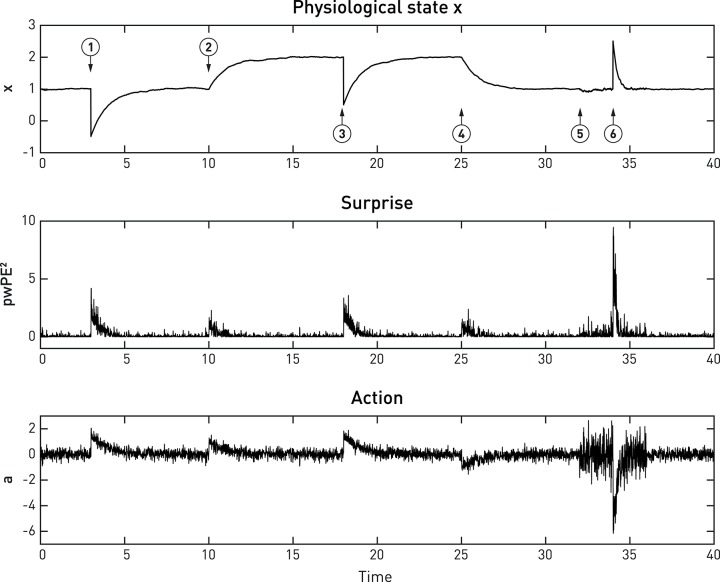Figure 6.
A simulated example of allostatic regulation of homeostatic control, based on Equations (8)–(12). The upper panel shows the temporal evolution of a fictitious physiological state x (Equation 11) which is affected by environmental perturbations (➊,➌,➏; all with a magnitude of 1.5). The middle and lower panels display an approximation to interoceptive surprise—i.e., squared precision-weighted prediction error (pwPE2; compare last line of Equation 8)—and the associated action signal (Equation 10), respectively. Following the timeline from left to right, the homeostatic setpoint or belief is initially specified with a prior mean and prior precision of 1 each. Please note that even before the first perturbation (➊) occurs, sensory noise (zero mean, 0.25 standard deviation) leads to ongoing actions of minute amplitude which lead to (very small) deviations of x from the setpoint. Following a first perturbation (➊), the homeostatic reflex arc emits corrective actions that are proportional to precision-weighted viscerosensory prediction error (middle panel). As the actions are successful, x returns to setpoint and viscerosensory prediction error decays. ➋ indicates the beginning of allostatic control: here, the prediction of imminent future perturbations (by some generative model not specified here) leads to an anticipatory rise in the homeostatic setpoint (a shift in the prior mean to 2). As a consequence, in the absence of any change in sensory input, actions are elicited to change the value of x to the new setpoint. This ensures that the following perturbation ➌ does not bring x anywhere near the critical threshold. At ➍, a safe period is predicted, and allostatic control resets the homeostatic setpoint (prior mean) to 1. At ➎, another perturbation in the near future is being predicted, however, this time the direction of the perturbation is uncertain. Therefore, changing the mean or setpoint is not a viable option and allostatic control takes a different form: instead of changing prior mean, the prior precision of the homeostatic belief is increased from 1 to 4. As a consequence, when a perturbation occurs at ➏, this yields a considerably larger precision-weighted prediction error and hence greater interoceptive surprise (see lower panel), leading to a significantly more rapid corrective action (compare the slope of signal rise between ➊ and ➏), putting the agent at less risk, should another perturbation occur shortly after ➏. It is also noteworthy that the increased prior precision enhances the effect of sensory noise (compare the roughness of the three signals just prior to ➊ and ➏, respectively).

